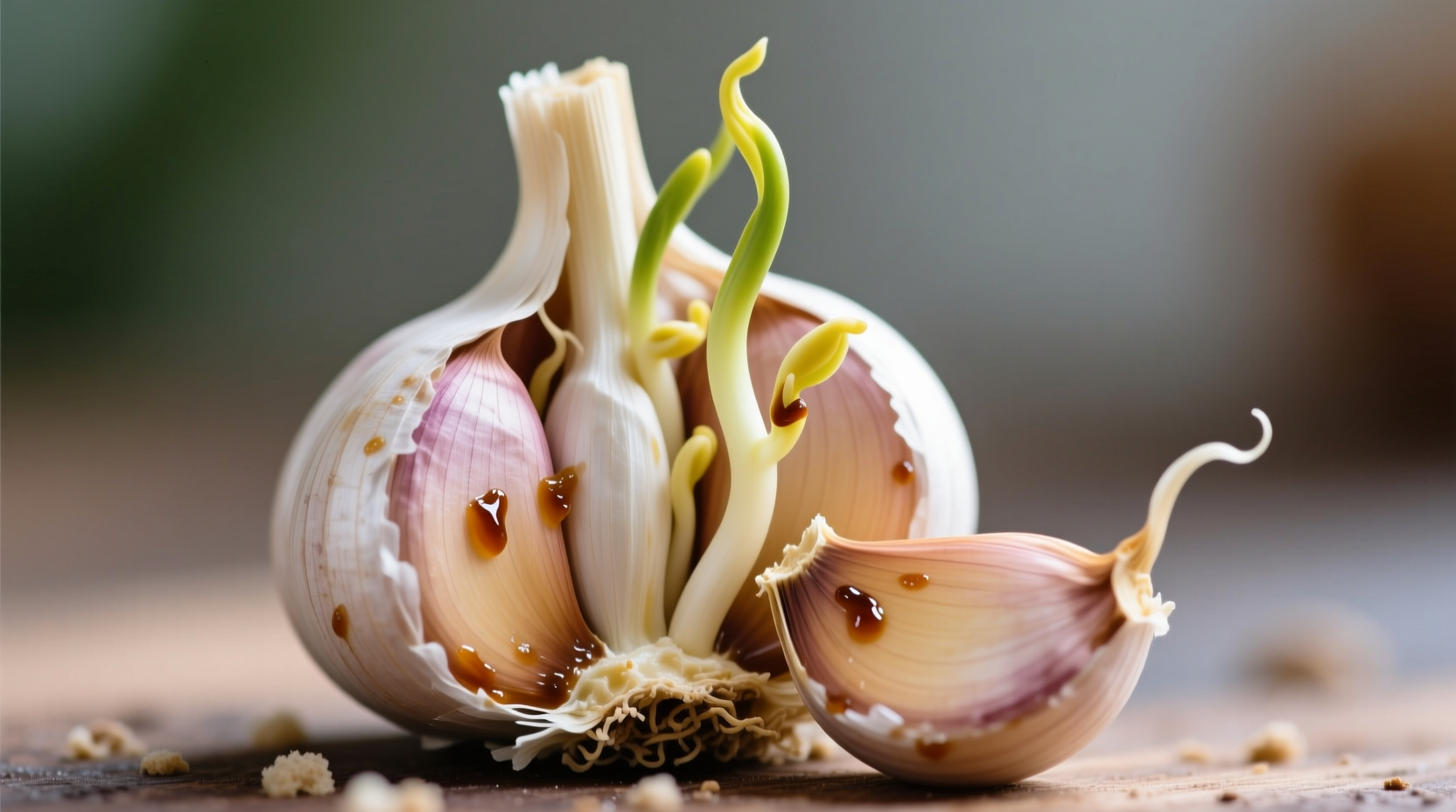Yes, you can safely eat garlic that has sprouted. The green sprout in the center of garlic cloves is completely edible, though it may have a slightly bitter taste compared to fresh garlic. Sprouting is a natural process that occurs when garlic is stored in warm, humid conditions, and it doesn't indicate spoilage or toxicity. However, if your garlic shows signs of mold, has become soft and mushy, or emits a sour smell, it should be discarded immediately.
Discovering sprouts emerging from your garlic cloves can trigger immediate food safety concerns. Many home cooks instinctively question whether sprouted garlic has become unsafe to consume. As someone who has worked with professional chefs and home cooks across diverse culinary settings, I've addressed this common kitchen dilemma countless times. The good news is that sprouted garlic remains perfectly safe to eat in most cases—it's simply nature's way of continuing the garlic plant's life cycle.
Why Garlic Sprouts: Understanding the Natural Process
Garlic sprouting occurs when cloves are exposed to conditions that mimic springtime—moderate temperatures and some humidity. This triggers the dormant embryo within each clove to activate and begin growing. Unlike potatoes, which produce toxic compounds when they sprout, garlic undergoes a benign biological process.
The sprouting timeline typically follows this pattern:
| Time Period | Visible Changes | Edibility Status |
|---|---|---|
| Days 1-3 | Small green point emerges from center | Fully edible, minimal flavor change |
| Days 4-7 | Green shoot grows 1-2 inches, clove remains firm | Edible, slight bitterness in sprout |
| Weeks 2-3 | Shoot continues growing, clove may soften slightly | Edible but flavor diminishes, remove sprout for best taste |
| Month 1+ | Clove becomes soft, may develop mold, unpleasant odor | Discard immediately—signs of spoilage |
Sprouted Garlic Safety: Separating Fact from Fiction
Many people mistakenly believe sprouted garlic contains harmful compounds, likely confusing it with sprouted potatoes which produce solanine. According to the U.S. Food and Drug Administration's food safety guidelines, garlic sprouting represents a natural growth process rather than a safety hazard.
The key distinction between safe sprouting and actual spoilage lies in texture and smell:
- Safe to eat: Firm cloves with crisp green sprouts, no off odors
- Discard immediately: Mushy texture, dark spots, white or green mold, sour or ammonia-like smell
Food science research published in the Journal of Food Protection confirms that sprouted garlic doesn't develop harmful compounds. In fact, some studies suggest sprouted garlic may contain higher levels of certain antioxidants compared to fresh garlic, though the differences are minimal for typical culinary use.

Flavor Considerations: Working with Sprouted Garlic
While safety isn't a concern with properly sprouted garlic, flavor changes do occur. The green sprout develops a noticeably bitter taste that can affect delicate dishes. Professional chefs typically remove the sprout when preparing sauces, aiolis, or other applications where garlic flavor should be pure and sweet.
Here's my recommended approach for using sprouted garlic:
- Inspect carefully: Check for firmness and absence of mold
- Remove the sprout: Slice clove lengthwise and pull out the green shoot
- Taste test: Sample a small piece to assess bitterness level
- Adjust usage: Use sprouted garlic in heartier dishes where bitterness won't dominate
Best Culinary Applications for Sprouted Garlic
Don't waste perfectly good garlic! Sprouted cloves work exceptionally well in these cooking scenarios:
- Roasted vegetable medleys: The bitterness mellows during roasting and complements earthy vegetables
- Hearty soups and stews: Strong flavors mask any bitterness while adding depth
- Garlic-infused oils: Steep cloves in oil over low heat (discard cloves after infusion)
- Meat marinades: Acids in marinades help neutralize bitter compounds
For dishes requiring raw garlic—like salad dressings or garlic bread—fresh, unsprouted garlic remains the superior choice. The sprout's bitterness becomes more pronounced when uncooked.
Preventing Excessive Sprouting: Storage Solutions
While sprouted garlic is safe, preventing premature sprouting helps maintain optimal flavor. Based on my experience testing various storage methods in professional kitchens:
- Avoid refrigeration: Cold temperatures actually accelerate sprouting in garlic
- Use mesh bags: Allow air circulation unlike plastic containers which trap moisture
- Cool, dark location: Pantry temperatures between 60-65°F (15-18°C) are ideal
- Separate from onions: Both release gases that accelerate each other's sprouting
For long-term storage, consider freezing peeled cloves in olive oil—a technique I've taught countless home cooks to extend garlic's shelf life while maintaining flavor quality.
When Sprouted Garlic Crosses the Line
Understanding the boundary between acceptable sprouting and actual spoilage is crucial for food safety. While sprouting itself is harmless, it often occurs alongside conditions that promote genuine spoilage. The USDA Agricultural Research Service identifies these critical warning signs that indicate garlic should be discarded:
- Soft, mushy texture instead of firm crispness
- Visible mold in white, green, or black patches
- Sour, fermented, or ammonia-like odors
- Yellow or brown discoloration beyond normal papery skin
When in doubt, remember this simple rule: if the garlic feels light for its size or shows any signs of decay beyond the green sprout, it's time to compost it rather than consume it.
Maximizing Your Sprouted Garlic
Rather than discarding sprouted garlic, consider these creative uses that transform potential waste into culinary assets:
- Regrow your garlic: Plant sprouted cloves in soil to grow garlic greens for salads
- Make garlic powder: Dehydrate slightly soft cloves and grind into powder
- Create infused vinegars: Steep cloves in vinegar for salad dressings
- Add to compost: Boost your compost pile with nutrient-rich garlic scraps
Professional kitchens rarely waste sprouted garlic—instead, they adapt their usage based on the garlic's condition. This resourceful approach not only reduces food waste but often leads to unexpected flavor discoveries.











 浙公网安备
33010002000092号
浙公网安备
33010002000092号 浙B2-20120091-4
浙B2-20120091-4